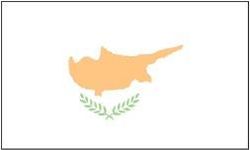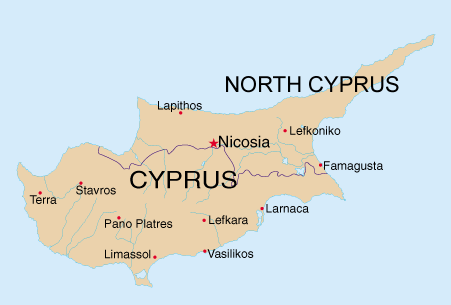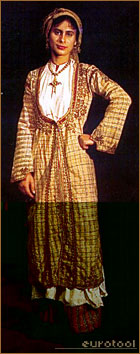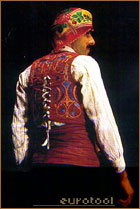Cyprus
 Flag of Cyprus | |
| Capital | Nicosia |
| Inhabitants | 803.147 |
| Language(s) | English |
Cyprus is an island country in the northeast corner of the Mediterranean Sea. It lies about 64 kilometers south of Turkey and 100 kilometers west of Syria. Geographically, Cyprus is part of Asia. But its people live much like southern Europeans and have a relatively high standard of living. Cyprus is a scenic country noted for its hilltop castles, old churches, beaches, and rugged mountains.
Independence from the UK was approved in 1960 with constitutional guarantees by the Greek Cypriot majority to the Turkish Cypriot minority. In 1974, a Greek-sponsored attempt to seize the government was met by military intervention from Turkey, which soon controlled almost 40% of the island.
In 1983, the Turkish-held area declared itself the "Turkish Republic of Northern Cyprus", but it is recognized only by Turkey. UN-led talks on the status of Cyprus resumed in December 1999 to prepare the ground for meaningful negotiations leading to a comprehensive settlement.
Contents |
History
It is not possible to say when first inhabitants of Cyprus lived, but it is believed possible that as long ago as 8.500 B.C. there were settlements on Cyprus.
Cyprus has had many names, but the name we use now is believed to have come from the word copper of which there was, and possibly still is, an abundance of on the island. An alternative theory is that its name comes from the word Kypros (the Greek for henna) of which there was also abundance. No one knows for sure.
Cyprus has had a troubled history. The abundance of copper, timber, and the strategic location between East and West resulted in repeated invasions, changes of rulers, and strife for the inhabitants.
Before the annexation to Rome in 58 B.C. Phoenicians, Archaeans, Assyrians, Egyptians, Persians, and Greeks colonized Cyprus.
In 43 A.D. Christianity came to Cyprus and in 330 A.D. Cyprus became part of the Eastern Roman or Byzantine Empire. And so it remained until 1191 when Richard the Lionheart, on his way to the Holy Land to fight the 3rd Crusade, conquered the island. A year later Richard sold the island to the Knights Templar for 100,000 Byzants. The Knights Templar, unable to exploit the island satisfactorily, then returned the island to Richard who sold it to the French nobleman Guy de Lusignan. The Lusignan dynasty ruled the island for the next three hundred years - a rule that was often oppressive, effectively reducing Cypriots to serfdom.
In 1489 the Lusignan King James died leaving the Kingdom to his Venetian wife who abdicated giving the island to Venice. The Venetians saw Cyprus primarily as a military base and built fortifications all over the island. Cypriots, at that time, were seen merely as a populous to be taxed as much as possible. In fact, it is said that Venetian rule was so unpleasant that when the Ottomans arrived in Cyprus in 1571 the locals felt as if they had been liberated from slavery.
The Ottomans abolished serfdom and instated the Orthodox Church as the Church, of Cyprus. They also made being Catholic a punishable offense, so Cypriots had to choose between Orthodox Christianity and Islam. The majority chose Christianity, but the result was that the population began to take on the ethnic structure it still possesses today, namely Greek and Turkish.
The Ottoman Empire entering the First World War on the side of Germany and emerged defeated, partly occupied by foreign powers, and with harsh restrictions imposed, Cyprus became a part of the British colonies, following the Treaty of Lausanne in 1925 In 1960 the Treaty of Zurich was signed to give independence to Cyprus whilst protecting the rights of the Turkish Cypriot population. The guarantors of this treaty were Britain, Greece, and Turkey.
In 1963 relations between the two communities separated by language, culture and religion, had deteriorated. 13 articles of the Constitution were attempted to be changed in favour of Greek Cypriot community, also disarming Turkish Cypriot Police and establishing the National Greek Cypriot Guards. These measures were in clear contravention of the Treaty of Zurich. Civil war began, and the United Nations sent in troops in an attempt to restore peace, creating the Green Line, which effectively divided the communities.
In 1974 Greece attempted a military coup in conjunction with the Greek National Guard in a bid to achieve ENOSIS (Idea of union with Greece).
On the 20th July 1974, Turkey, after consultation with Britain, intervened military, namely Peace-Keeping Action to protect the Turkish Cypriot community. This was in exercise of the powers of guarantee agreed in the Treaty of Zurich.
Culture
Cypriots are very proud of their cultural heritage, which stretches back more than 9000 years. However, you'll probably find that Cyprus today is more concerned with the events of the last 20 years than those of a millennium ago. The north of the island is busy re-creating itself in the image of Turkey, changing names to Turkish and embracing the life and culture of its northern neighbor. The Republic is also trying to create an independent identity, and many places in the Republic have recently been renamed as well.
Art
Whatever the present-day situation may be, Cyprus is littered with reminders of the island's history.
Relics from every era - Greek temples, Roman mosaics and 15th-century frescoes - influence the artists of today. Many villages specialize in a particular art form, and as you travel around Cyprus you'll see pottery, silver and copperware, basket weaving, tapestry and Lefkara's famous lacework.
Religion
Like everything else in Cyprus, religion is split along the Green Line. The northerners are mostly Sunni Muslim, the southerners Greek Orthodox.
Food
Food, too, reflects the divide: in the North you'll find mostly Turkish cuisine; in the Republic, Greek. But wherever you are in Cyprus, you'll come across kleftiko (oven-baked lamb) and mezedes (dips, salads and other appetisers). Cyprus is also famous for its fruit, which the government protects with a ban on imported products. You'll find strawberries, stone fruit, melons, prickly pear, citrus and grapes.
Dance
Cypriot men used to dance mostly during wedding festivities and at various junkets on high days and holidays, but also in coffee-houses in the evenings, on threshing-floors, and wherever men gathered together. Social convention restricted occasions when women danced mainly to weddings.
In the period we are considering, roughly from 1910 to the seventies, the basic dance of both men and women was the "kartchilamas" performed by a confronted pair of dancers. The "kartchilamas" consists of a series of dances that vary slightly according to the performers, the locality, or the era. These dances are essentially parts of a whole, or suite, the parts being known as the "kartchilamas" or "first", "second", "third", "fourth", and "fifth" or "balos", rounded off by other dances such as the "syrtos", "zeipekkikos", and "mandra". A feast would usually end with one of the pan-Hellenic dances, the "kalamatianos", a circle-dance in which all might join.
Cypriot dances are mainly of the type performed by a confronted pair, invariably two men or two women, or men's solo dances displaying virtuosity and often performed with a hand-held object, either a sickle, knife, sieve, or tumbler. In their steps and general characteristics - such as the movement of the body and limbs - they have features in common with dances of the historic Greek island area (the Asia Minor seaboard, Aegean islands and cities, and the Ionian isles). Apart from these common features, Cypriot dances are distinguished by steps peculiar to certain localities, such as stamping in one spot with the feet, crossed alternately in front of each other, in the "second" and particularly the "third" ""kartchilamas"" and in the "syrtos" for men. Improvisation is another characteristic of Cypriot dances and may be attributed to their being performed by only two people and so to an overriding sense of comparison and, by extension, of competition. But it is to be noted that improvisation and the freedom of the dancer to do his own thing are constrained by the community's severe strictures upon any excesses. Indeed, the more inward-looking the community, the more rigorous the restraints.
National holidays
- Jan 1: First Day of January
- Mar 10: Green Monday
- Mar 25: Greek Independence Day
- Apr 1: Cyprus National Day
- Apr 25: Good Friday
- Apr 28/29: After Easter
- May 1: Labour Day
- Jun 16: Holy Spirit
- Aug 15: Assumption Day
- Oct 1: Cyprus Independence Day
- Oct 28: Greek National Day
- Dec 25: Christmas Day
- Dec 26: After Christmas Day
Embassies
Embassies In the Republic of Cyprus
- Embassy of the United States in Nicosia
- Permanent Mission of Cyprus to the United Nations in New York
Embassies of the Republic of Cyprus
- Cyprus Trade Center in Cologne, Germany
- Consulate of the Republic of Cyprus in Sicily, Italy
- Embassy of Cyprus in Mexico City, Mexico
- Cyprus Tourism Organization in New York, United States of America
- Cyprus Trade Center in New York, United States of America
- Permanent Mission of Cyprus to the United Nations in New York


